8.4. IMDB Movie Review classification#
Author: Johannes Maucher
Last Update: 16.07.2024
8.4.1. Text-Classification in general#
Until this stage of the lecture you should be aware of the following 4 different approaches for text classification:
Bag-of-Word + Conventional ML: This is a quite old approach for text classifications. Texts are modelled as Bag-of-Word vectors and these numeric vectors can be passed to any conventional ML algorithm e.g. Naive Bayes, Logistic Regresseion, SVM, SLP, MLP, …
Embedding-Bag + Conventional ML:

Fig. 8.1 Embedding-Bag: For each word in the text a word embedding is calculated and all embeddings are added. The resulting summed vector is passed to any conventional ML algorithm.#
Word Embeddings passed to a 1D-CNNL:
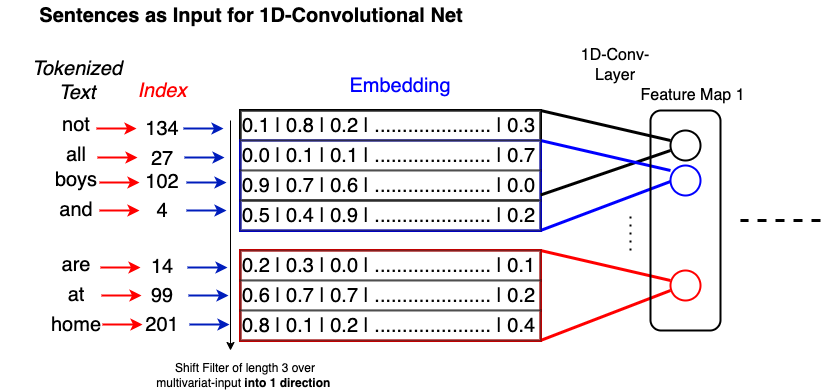
Fig. 8.2 Embeddings of the words in the text are passed in order to the input of a 1-D CNN.#
Word Embeddings passed to a RNN (any type of RNN):
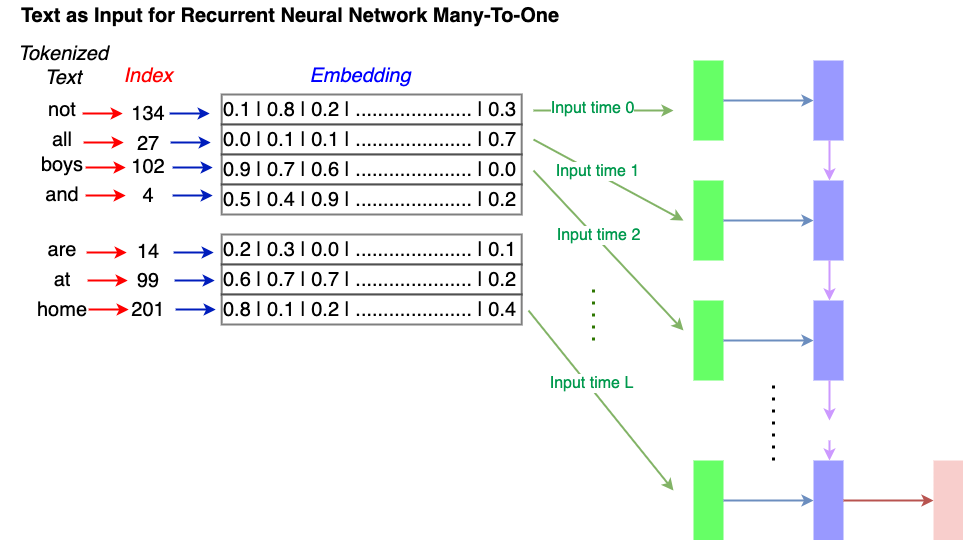
Fig. 8.3 Embeddings of the words in the text are passed in order to the input of a RNN of any type.#
In this notebook we implement approach 3 and 4 for classifying IMDB movie reviews. Later on you will also learn how a Transformer like BERT can be applied for text-classification.
8.4.2. Access IMDB dataset#
The IMDB Movie Review corpus is a standard dataset for the evaluation of text-classifiers. It consists of 25000 movies reviews from IMDB, labeled by sentiment (positive/negative). In this notebook a Convolutional Neural Network (CNN) is implemented for sentiment classification of IMDB reviews.
import numpy as np
import pandas as pd
from tensorflow.keras.preprocessing.text import Tokenizer
from tensorflow.keras.preprocessing.sequence import pad_sequences
from tensorflow.keras.utils import to_categorical
from tensorflow.keras.layers import Embedding, Dense, Input, Flatten, Conv1D, MaxPooling1D, Dropout, Concatenate, GlobalMaxPool1D
from tensorflow.keras.models import Model
from tensorflow.keras.datasets import imdb
2024-12-09 20:41:04.905965: E external/local_xla/xla/stream_executor/cuda/cuda_dnn.cc:9261] Unable to register cuDNN factory: Attempting to register factory for plugin cuDNN when one has already been registered
2024-12-09 20:41:04.906111: E external/local_xla/xla/stream_executor/cuda/cuda_fft.cc:607] Unable to register cuFFT factory: Attempting to register factory for plugin cuFFT when one has already been registered
2024-12-09 20:41:05.173575: E external/local_xla/xla/stream_executor/cuda/cuda_blas.cc:1515] Unable to register cuBLAS factory: Attempting to register factory for plugin cuBLAS when one has already been registered
2024-12-09 20:41:05.744627: I tensorflow/core/platform/cpu_feature_guard.cc:182] This TensorFlow binary is optimized to use available CPU instructions in performance-critical operations.
To enable the following instructions: AVX2 FMA, in other operations, rebuild TensorFlow with the appropriate compiler flags.
2024-12-09 20:41:09.347972: W tensorflow/compiler/tf2tensorrt/utils/py_utils.cc:38] TF-TRT Warning: Could not find TensorRT
MAX_NB_WORDS = 10000 # number of most-frequent words that are regarded, all others are ignored
EMBEDDING_DIM = 100 # dimension of word-embedding
INDEX_FROM=3
The IMDB dataset is already available in Keras and can easily be accessed by
imdb.load_data().
The returned dataset contains the sequence of word indices for each review.
(X_train, y_train), (X_test, y_test) = imdb.load_data(num_words=MAX_NB_WORDS,index_from=INDEX_FROM)
print(X_train.shape)
print(X_test.shape)
print(y_train.shape)
print(y_test.shape)
(25000,)
(25000,)
(25000,)
(25000,)
First 15 tokens of the first training document:
X_train[0][:15] #plot first 10 elements of the sequence
[1, 14, 22, 16, 43, 530, 973, 1622, 1385, 65, 458, 4468, 66, 3941, 4]
First 15 tokens of the second training document:
X_train[1][:15] #plot first 10 elements of the sequence
[1, 194, 1153, 194, 8255, 78, 228, 5, 6, 1463, 4369, 5012, 134, 26, 4]
First 15 tokens of the third training document:
X_train[2][:15] #plot first 10 elements of the sequence
[1, 14, 47, 8, 30, 31, 7, 4, 249, 108, 7, 4, 5974, 54, 61]
The representation of text as sequence of integers is good for Machine Learning algorithms, but useless for human text understanding. Therefore, we also access the word-index from Keras IMDB dataset, which maps words to the associated integer-IDs. Since we like to map integer-IDs to words we calculate the inverse wordindex inv_wordindex:
wordindex=imdb.get_word_index(path="imdb_word_index.json")
Example: Index of word the:
wordindex["the"]
1
As can be seen, in the output above the index of word the is 1. This is because the index is ordered w.r.t. the frequency of words in the dictionary and the is the most frequent word.
However, the wordindex which we got from imdb.get_word_index() is not exactly the index, which has been applied in the indexing of imdb-reviews, which are returned by the method imdb.load_data(). The difference is a shift of 3 in the indexes. I.e. in the reviews, returned by imdb.load_data() the word the is represented by the integer 4. This is because in the vocabulary applied for imdb.load_data() four special tokens are added at the first index-positions. We also have to add this special tokens, if we like to decode our integer-sequences to real texts:
wordindex = {k:(v+INDEX_FROM) for k,v in wordindex.items()}
wordindex["<PAD>"] = 0
wordindex["<START>"] = 1
wordindex["<UNK>"] = 2
wordindex["<UNUSED>"] = 3
Now the index of word the is:
wordindex["the"]
4
Next, we calculate the inverse wordindex, which maps integers to words:
inv_wordindex = {value:key for key,value in wordindex.items()}
Now, we can decode the integer-sequences of our reviews into real texts. The first film-review of the training-partition then reads as follows:
print(' '.join(inv_wordindex[id] for id in X_train[1] ))
<START> big hair big boobs bad music and a giant safety pin these are the words to best describe this terrible movie i love cheesy horror movies and i've seen hundreds but this had got to be on of the worst ever made the plot is paper thin and ridiculous the acting is an abomination the script is completely laughable the best is the end showdown with the cop and how he worked out who the killer is it's just so damn terribly written the clothes are sickening and funny in equal <UNK> the hair is big lots of boobs <UNK> men wear those cut <UNK> shirts that show off their <UNK> sickening that men actually wore them and the music is just <UNK> trash that plays over and over again in almost every scene there is trashy music boobs and <UNK> taking away bodies and the gym still doesn't close for <UNK> all joking aside this is a truly bad film whose only charm is to look back on the disaster that was the 80's and have a good old laugh at how bad everything was back then
Next the distribution of review-lengths (words per review) is calculated:
textlenghtsTrain=[len(t) for t in X_train]
from matplotlib import pyplot as plt
plt.hist(textlenghtsTrain,bins=20)
plt.title("Distribution of text lengths in words")
plt.xlabel("number of words per document")
plt.show()
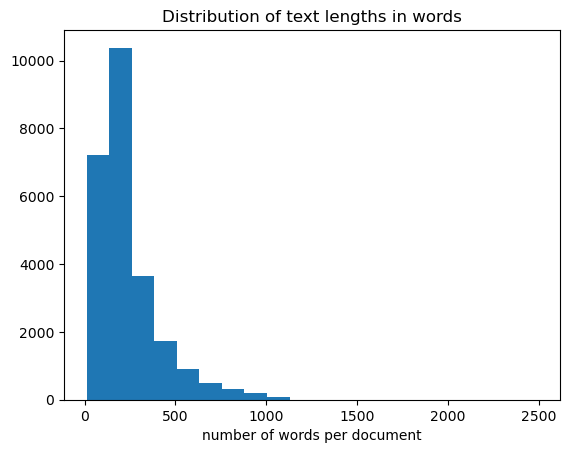
Given this length-distribution, we set our sequence length as follows:
MAX_SEQUENCE_LENGTH = 500 # all text-sequences are padded to this length
8.4.3. Preparing Text Sequences and Labels#
All sequences must be padded to unique length of MAX_SEQUENCE_LENGTH. This means, that longer sequences are cut and shorter sequences are filled with zeros. For this Keras provides the pad_sequences()-function.
X_train = pad_sequences(X_train, maxlen=MAX_SEQUENCE_LENGTH)
X_test = pad_sequences(X_test, maxlen=MAX_SEQUENCE_LENGTH)
Moreover, all class-labels must be represented in one-hot-encoded form:
y_train = to_categorical(np.asarray(y_train))
y_test = to_categorical(np.asarray(y_test))
print('Shape of Training Data Input:', X_train.shape)
print('Shape of Training Data Labels:', y_train.shape)
Shape of Training Data Input: (25000, 500)
Shape of Training Data Labels: (25000, 2)
print('Number of positive and negative reviews in training and validation set ')
print (y_train.sum(axis=0))
print (y_test.sum(axis=0))
Number of positive and negative reviews in training and validation set
[12500. 12500.]
[12500. 12500.]
8.4.4. CNN with 2 Convolutional Layers#
The first network architecture consists of
an embedding layer. This layer takes sequences of integers and learns word-embeddings. The sequences of word-embeddings are then passed to the first convolutional layer
two 1D-convolutional layers with different number of filters and different filter-sizes
two Max-Pooling layers to reduce the number of neurons, required in the following layers
a MLP classifier with one hidden layer and the output layer
8.4.4.1. Prepare Embedding Matrix and -Layer#
embedding_layer = Embedding(MAX_NB_WORDS,
EMBEDDING_DIM,
#weights=[embedding_matrix],
input_length=MAX_SEQUENCE_LENGTH,
trainable=True)
8.4.4.2. Define CNN architecture#
sequence_input = Input(shape=(MAX_SEQUENCE_LENGTH,), dtype='int32')
embedded_sequences = embedding_layer(sequence_input)
l_cov1= Conv1D(32, 5, activation='relu')(embedded_sequences)
l_pool1 = MaxPooling1D(2)(l_cov1)
l_cov2 = Conv1D(64, 3, activation='relu')(l_pool1)
l_pool2 = MaxPooling1D(5)(l_cov2)
l_flat = Flatten()(l_pool2)
l_dense = Dense(64, activation='relu')(l_flat)
preds = Dense(2, activation='softmax')(l_dense)
model = Model(sequence_input, preds)
2024-12-09 21:10:01.898705: W tensorflow/core/common_runtime/gpu/gpu_device.cc:2256] Cannot dlopen some GPU libraries. Please make sure the missing libraries mentioned above are installed properly if you would like to use GPU. Follow the guide at https://www.tensorflow.org/install/gpu for how to download and setup the required libraries for your platform.
Skipping registering GPU devices...
8.4.4.3. Train Network#
model.compile(loss='categorical_crossentropy',
optimizer='rmsprop',
metrics=['categorical_accuracy'])
model.summary()
Model: "model"
_________________________________________________________________
Layer (type) Output Shape Param #
=================================================================
input_1 (InputLayer) [(None, 500)] 0
embedding (Embedding) (None, 500, 100) 1000000
conv1d (Conv1D) (None, 496, 32) 16032
max_pooling1d (MaxPooling1 (None, 248, 32) 0
D)
conv1d_1 (Conv1D) (None, 246, 64) 6208
max_pooling1d_1 (MaxPoolin (None, 49, 64) 0
g1D)
flatten (Flatten) (None, 3136) 0
dense (Dense) (None, 64) 200768
dense_1 (Dense) (None, 2) 130
=================================================================
Total params: 1223138 (4.67 MB)
Trainable params: 1223138 (4.67 MB)
Non-trainable params: 0 (0.00 Byte)
_________________________________________________________________
print("model fitting - simplified convolutional neural network")
history=model.fit(X_train, y_train, validation_data=(X_test, y_test),epochs=6, verbose=False, batch_size=128)
model fitting - simplified convolutional neural network
%matplotlib inline
from matplotlib import pyplot as plt
acc = history.history['categorical_accuracy']
val_acc = history.history['val_categorical_accuracy']
max_val_acc=np.max(val_acc)
epochs = range(1, len(acc) + 1)
plt.figure(figsize=(8,6))
plt.plot(epochs, acc, 'bo', label='Training accuracy')
plt.plot(epochs, val_acc, 'b', label='Validation accuracy')
plt.title('Training and validation accuracy')
plt.grid(True)
plt.legend()
plt.show()

model.evaluate(X_test,y_test)
782/782 [==============================] - 5s 7ms/step - loss: 0.5011 - categorical_accuracy: 0.8498
[0.5010811686515808, 0.8497599959373474]
As shown above, after 6 epochs of training the cross-entropy-loss is 0.501 and the accuracy is 84.98%. However, it seems that the accuracy-value after 3 epochs has been higher, than the accuracy after 6 epochs. This indicates overfitting due to too long learning.
8.4.5. CNN with different filter sizes in one layer#
In Y. Kim; Convolutional Neural Networks for Sentence Classification a CNN with different filter-sizes in one layer has been proposed. This CNN is implemented below:

Source: Y. Kim; Convolutional Neural Networks for Sentence Classification
8.4.5.1. Prepare Embedding Matrix and -Layer#
embedding_layer = Embedding(MAX_NB_WORDS,
EMBEDDING_DIM,
#weights=[embedding_matrix],
input_length=MAX_SEQUENCE_LENGTH,
trainable=True)
8.4.5.2. Define Architecture#
convs = []
filter_sizes = [3,4,5]
sequence_input = Input(shape=(MAX_SEQUENCE_LENGTH,), dtype='int32')
embedded_sequences = embedding_layer(sequence_input)
for fsz in filter_sizes:
l_conv = Conv1D(filters=32,kernel_size=fsz,activation='relu')(embedded_sequences)
l_pool = MaxPooling1D(4)(l_conv)
convs.append(l_pool)
l_merge = Concatenate(axis=1)(convs)
l_cov1= Conv1D(64, 5, activation='relu')(l_merge)
l_pool1 = GlobalMaxPool1D()(l_cov1)
#l_cov2 = Conv1D(128, 5, activation='relu')(l_pool1)
#l_pool2 = MaxPooling1D(30)(l_cov2)
l_flat = Flatten()(l_pool1)
l_dense = Dense(64, activation='relu')(l_flat)
preds = Dense(2, activation='softmax')(l_dense)
model = Model(sequence_input, preds)
model.summary()
Model: "model_1"
__________________________________________________________________________________________________
Layer (type) Output Shape Param # Connected to
==================================================================================================
input_2 (InputLayer) [(None, 500)] 0 []
embedding_1 (Embedding) (None, 500, 100) 1000000 ['input_2[0][0]']
conv1d_2 (Conv1D) (None, 498, 32) 9632 ['embedding_1[0][0]']
conv1d_3 (Conv1D) (None, 497, 32) 12832 ['embedding_1[0][0]']
conv1d_4 (Conv1D) (None, 496, 32) 16032 ['embedding_1[0][0]']
max_pooling1d_2 (MaxPoolin (None, 124, 32) 0 ['conv1d_2[0][0]']
g1D)
max_pooling1d_3 (MaxPoolin (None, 124, 32) 0 ['conv1d_3[0][0]']
g1D)
max_pooling1d_4 (MaxPoolin (None, 124, 32) 0 ['conv1d_4[0][0]']
g1D)
concatenate (Concatenate) (None, 372, 32) 0 ['max_pooling1d_2[0][0]',
'max_pooling1d_3[0][0]',
'max_pooling1d_4[0][0]']
conv1d_5 (Conv1D) (None, 368, 64) 10304 ['concatenate[0][0]']
global_max_pooling1d (Glob (None, 64) 0 ['conv1d_5[0][0]']
alMaxPooling1D)
flatten_1 (Flatten) (None, 64) 0 ['global_max_pooling1d[0][0]']
dense_2 (Dense) (None, 64) 4160 ['flatten_1[0][0]']
dense_3 (Dense) (None, 2) 130 ['dense_2[0][0]']
==================================================================================================
Total params: 1053090 (4.02 MB)
Trainable params: 1053090 (4.02 MB)
Non-trainable params: 0 (0.00 Byte)
__________________________________________________________________________________________________
8.4.5.3. Train Network#
model.compile(loss='categorical_crossentropy',
optimizer='rmsprop',
metrics=['categorical_accuracy'])
print("model fitting - more complex convolutional neural network")
history=model.fit(X_train, y_train, validation_data=(X_test, y_test),epochs=8, batch_size=128)
model fitting - more complex convolutional neural network
Epoch 1/8
196/196 [==============================] - 55s 280ms/step - loss: 0.6112 - categorical_accuracy: 0.6336 - val_loss: 0.3946 - val_categorical_accuracy: 0.8298
Epoch 2/8
196/196 [==============================] - 55s 279ms/step - loss: 0.3409 - categorical_accuracy: 0.8531 - val_loss: 0.3042 - val_categorical_accuracy: 0.8718
Epoch 3/8
196/196 [==============================] - 54s 278ms/step - loss: 0.2382 - categorical_accuracy: 0.9030 - val_loss: 0.2883 - val_categorical_accuracy: 0.8818
Epoch 4/8
196/196 [==============================] - 54s 278ms/step - loss: 0.1749 - categorical_accuracy: 0.9341 - val_loss: 0.2858 - val_categorical_accuracy: 0.8885
Epoch 5/8
196/196 [==============================] - 55s 280ms/step - loss: 0.1228 - categorical_accuracy: 0.9556 - val_loss: 0.2974 - val_categorical_accuracy: 0.8880
Epoch 6/8
196/196 [==============================] - 54s 278ms/step - loss: 0.0839 - categorical_accuracy: 0.9724 - val_loss: 0.3450 - val_categorical_accuracy: 0.8811
Epoch 7/8
196/196 [==============================] - 55s 280ms/step - loss: 0.0505 - categorical_accuracy: 0.9849 - val_loss: 0.4407 - val_categorical_accuracy: 0.8728
Epoch 8/8
196/196 [==============================] - 55s 279ms/step - loss: 0.0297 - categorical_accuracy: 0.9912 - val_loss: 0.4342 - val_categorical_accuracy: 0.8812
acc = history.history['categorical_accuracy']
val_acc = history.history['val_categorical_accuracy']
max_val_acc=np.max(val_acc)
epochs = range(1, len(acc) + 1)
plt.figure(figsize=(8,6))
plt.plot(epochs, acc, 'bo', label='Training accuracy')
plt.plot(epochs, val_acc, 'b', label='Validation accuracy')
plt.title('Training and validation accuracy')
plt.grid(True)
plt.legend()
plt.show()
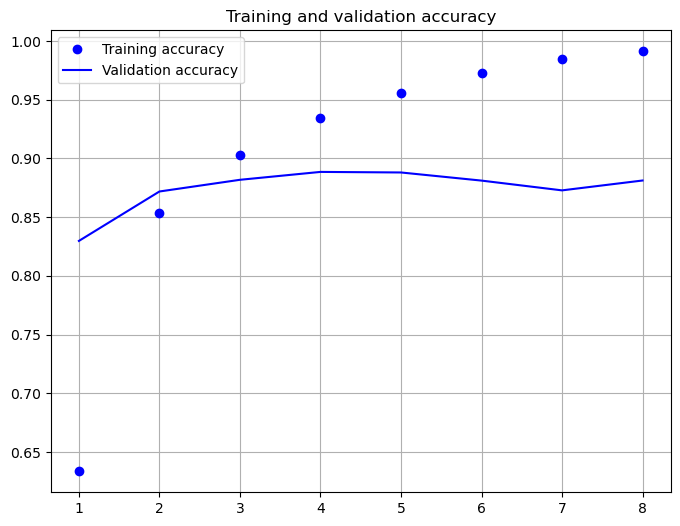
model.evaluate(X_test,y_test)
782/782 [==============================] - 11s 13ms/step - loss: 0.4342 - categorical_accuracy: 0.8812
[0.4342169463634491, 0.8812000155448914]
As shown above, after 8 epochs of training the cross-entropy-loss is 0.434 and the accuracy is 88.12%.
8.4.6. LSTM#
from tensorflow.keras.layers import LSTM, Bidirectional
embedding_layer = Embedding(MAX_NB_WORDS,
EMBEDDING_DIM,
#weights=[embedding_matrix],
input_length=MAX_SEQUENCE_LENGTH,
trainable=True)
sequence_input = Input(shape=(MAX_SEQUENCE_LENGTH,), dtype='int32')
embedded_sequences = embedding_layer(sequence_input)
l_lstm = Bidirectional(LSTM(64))(embedded_sequences)
preds = Dense(2, activation='softmax')(l_lstm)
model = Model(sequence_input, preds)
model.summary()
Model: "model_2"
_________________________________________________________________
Layer (type) Output Shape Param #
=================================================================
input_3 (InputLayer) [(None, 500)] 0
embedding_2 (Embedding) (None, 500, 100) 1000000
bidirectional (Bidirection (None, 128) 84480
al)
dense_4 (Dense) (None, 2) 258
=================================================================
Total params: 1084738 (4.14 MB)
Trainable params: 1084738 (4.14 MB)
Non-trainable params: 0 (0.00 Byte)
_________________________________________________________________
model.compile(loss='categorical_crossentropy',
optimizer='rmsprop',
metrics=['categorical_accuracy'])
print("model fitting - Bidirectional LSTM")
model fitting - Bidirectional LSTM
history=model.fit(X_train, y_train, validation_data=(X_test, y_test),epochs=6, batch_size=128)
Epoch 1/6
196/196 [==============================] - 150s 754ms/step - loss: 0.5227 - categorical_accuracy: 0.7223 - val_loss: 0.4264 - val_categorical_accuracy: 0.8202
Epoch 2/6
196/196 [==============================] - 147s 752ms/step - loss: 0.3275 - categorical_accuracy: 0.8640 - val_loss: 0.3937 - val_categorical_accuracy: 0.8202
Epoch 3/6
196/196 [==============================] - 147s 748ms/step - loss: 0.2750 - categorical_accuracy: 0.8924 - val_loss: 0.3298 - val_categorical_accuracy: 0.8605
Epoch 4/6
196/196 [==============================] - 147s 752ms/step - loss: 0.2407 - categorical_accuracy: 0.9097 - val_loss: 0.2941 - val_categorical_accuracy: 0.8808
Epoch 5/6
196/196 [==============================] - 147s 751ms/step - loss: 0.2142 - categorical_accuracy: 0.9184 - val_loss: 0.4389 - val_categorical_accuracy: 0.8352
Epoch 6/6
196/196 [==============================] - 147s 750ms/step - loss: 0.1928 - categorical_accuracy: 0.9289 - val_loss: 0.4811 - val_categorical_accuracy: 0.8514
acc = history.history['categorical_accuracy']
val_acc = history.history['val_categorical_accuracy']
max_val_acc=np.max(val_acc)
epochs = range(1, len(acc) + 1)
plt.figure(figsize=(8,6))
plt.plot(epochs, acc, 'bo', label='Training accuracy')
plt.plot(epochs, val_acc, 'b', label='Validation accuracy')
plt.title('Training and validation accuracy')
plt.grid(True)
plt.legend()
plt.show()

model.evaluate(X_test,y_test)
782/782 [==============================] - 42s 53ms/step - loss: 0.4811 - categorical_accuracy: 0.8514
[0.48110508918762207, 0.8514000177383423]
As shown above, after 6 epochs of training the cross-entropy-loss is 0.4811 and the accuracy is 85.14%. However, it seems that the accuracy-value after 2 epochs has been higher, than the accuracy after 6 epochs. This indicates overfitting due to too long learning.
8.4.7. Bidirectional LSTM architecture with Attention#
8.4.7.1. Define Custom Attention Layer#
Since Keras does not provide an attention-layer, we have to implement this type on our own. The implementation below corresponds to the attention-concept as introduced in Bahdanau et al: Neural Machine Translation by Jointly Learning to Align and Translate.
The general concept of writing custom Keras layers is described in the corresponding Keras documentation.
Any custom layer class inherits from the layer-class and must implement three methods:
build(input_shape): this is where you will define your weights. This method must setself.built = True, which can be done by callingsuper([Layer], self).build().call(x): this is where the layer’s logic lives. Unless you want your layer to support masking, you only have to care about the first argument passed to call: the input tensor.compute_output_shape(input_shape): in case your layer modifies the shape of its input, you should specify here the shape transformation logic. This allows Keras to do automatic shape inference.
from tensorflow.keras import regularizers, initializers,constraints
from tensorflow.keras.layers import Layer
import tensorflow.keras.backend as K
class Attention(Layer):
def __init__(self, step_dim,
W_regularizer=None, b_regularizer=None,
W_constraint=None, b_constraint=None,
bias=True, **kwargs):
self.supports_masking = True
self.init = initializers.get('glorot_uniform')
self.W_regularizer = regularizers.get(W_regularizer)
self.b_regularizer = regularizers.get(b_regularizer)
self.W_constraint = constraints.get(W_constraint)
self.b_constraint = constraints.get(b_constraint)
self.bias = bias
self.step_dim = step_dim
self.features_dim = 0
super(Attention, self).__init__(**kwargs)
def build(self, input_shape):
assert len(input_shape) == 3
self.W = self.add_weight(shape=(input_shape[-1],),
initializer=self.init,
name='{}_W'.format(self.name),
regularizer=self.W_regularizer,
constraint=self.W_constraint)
self.features_dim = input_shape[-1]
if self.bias:
self.b = self.add_weight(shape=(input_shape[1],),
initializer='zero',
#name='{}_b'.format(self.name),
regularizer=self.b_regularizer,
constraint=self.b_constraint)
else:
self.b = None
self.built = True
def compute_mask(self, input, input_mask=None):
return None
def call(self, x, mask=None):
features_dim = self.features_dim
step_dim = self.step_dim
eij = K.reshape(K.dot(K.reshape(x, (-1, features_dim)),
K.reshape(self.W, (features_dim, 1))), (-1, step_dim))
if self.bias:
eij += self.b
eij = K.tanh(eij)
a = K.exp(eij)
if mask is not None:
a *= K.cast(mask, K.floatx())
a /= K.cast(K.sum(a, axis=1, keepdims=True) + K.epsilon(), K.floatx())
a = K.expand_dims(a)
weighted_input = x * a
return K.sum(weighted_input, axis=1)
def compute_output_shape(self, input_shape):
return input_shape[0], self.features_dim
embedding_layer = Embedding(MAX_NB_WORDS,
EMBEDDING_DIM,
#weights=[embedding_matrix],
input_length=MAX_SEQUENCE_LENGTH,
trainable=True)
sequence_input = Input(shape=(MAX_SEQUENCE_LENGTH,), dtype='int32')
embedded_sequences = embedding_layer(sequence_input)
l_gru = Bidirectional(LSTM(64, return_sequences=True))(embedded_sequences)
l_att = Attention(MAX_SEQUENCE_LENGTH)(l_gru)
preds = Dense(2, activation='softmax')(l_att)
model = Model(sequence_input, preds)
model.summary()
Model: "model_3"
_________________________________________________________________
Layer (type) Output Shape Param #
=================================================================
input_5 (InputLayer) [(None, 500)] 0
embedding_4 (Embedding) (None, 500, 100) 1000000
bidirectional_2 (Bidirecti (None, 500, 128) 84480
onal)
attention_1 (Attention) (None, 128) 628
dense_5 (Dense) (None, 2) 258
=================================================================
Total params: 1085366 (4.14 MB)
Trainable params: 1085366 (4.14 MB)
Non-trainable params: 0 (0.00 Byte)
_________________________________________________________________
model.compile(loss='categorical_crossentropy',
optimizer='rmsprop',
metrics=['categorical_accuracy'])
history=model.fit(X_train, y_train, validation_data=(X_test, y_test),epochs=6, batch_size=128)
Epoch 1/6
196/196 [==============================] - 166s 837ms/step - loss: 0.6922 - categorical_accuracy: 0.5175 - val_loss: 0.6888 - val_categorical_accuracy: 0.5082
Epoch 2/6
196/196 [==============================] - 162s 829ms/step - loss: 0.5559 - categorical_accuracy: 0.7150 - val_loss: 0.3844 - val_categorical_accuracy: 0.8459
Epoch 3/6
196/196 [==============================] - 163s 831ms/step - loss: 0.3490 - categorical_accuracy: 0.8574 - val_loss: 0.3288 - val_categorical_accuracy: 0.8570
Epoch 4/6
196/196 [==============================] - 162s 829ms/step - loss: 0.2747 - categorical_accuracy: 0.8916 - val_loss: 0.3041 - val_categorical_accuracy: 0.8746
Epoch 5/6
196/196 [==============================] - 163s 832ms/step - loss: 0.2300 - categorical_accuracy: 0.9111 - val_loss: 0.2938 - val_categorical_accuracy: 0.8753
Epoch 6/6
196/196 [==============================] - 163s 830ms/step - loss: 0.1996 - categorical_accuracy: 0.9239 - val_loss: 0.2776 - val_categorical_accuracy: 0.8834
acc = history.history['categorical_accuracy']
val_acc = history.history['val_categorical_accuracy']
max_val_acc=np.max(val_acc)
epochs = range(1, len(acc) + 1)
plt.figure(figsize=(8,6))
plt.plot(epochs, acc, 'bo', label='Training accuracy')
plt.plot(epochs, val_acc, 'b', label='Validation accuracy')
plt.title('Training and validation accuracy')
plt.grid(True)
plt.legend()
plt.show()
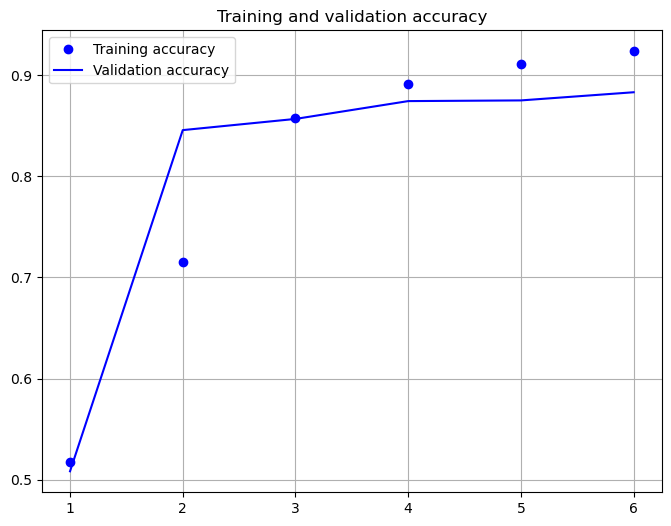
model.evaluate(X_test,y_test)
782/782 [==============================] - 45s 58ms/step - loss: 0.2776 - categorical_accuracy: 0.8834
[0.27762892842292786, 0.8833600282669067]
Again, the achieved accuracy is in the same range as for the other architectures. None of the architectures has been optimized, e.g. through hyperparameter-tuning. However, the goal of this notebook is not the determination of an optimal model, but the demonstration of how modern neural network architectures can be implemented for text-classification.
